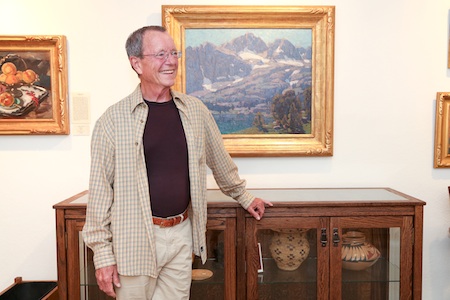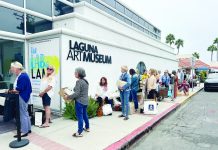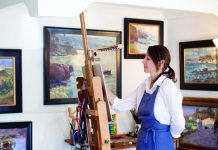
Few painters have captured the majesty of California’s mountain terrain as dramatically as Edgar Payne, at home in the Sierra Nevada as well as the shores of Laguna Beach and diverse settings in Europe and the American West.
Payne, who co-founded the Laguna Art Association early last century, returns to the limelight in “Edgar Payne: The Scenic Journey,” a retrospective show originating in Sacramento’s Crocker Art Museum, which now is ensconced at the Pasadena Museum of California Art until October when it moves to the Gilcrease Museum in Tulsa, Okla.
Exhibition curator Scott A. Shields and curatorial advisor Patricia Trenton turned to a behind-the-scenes art sleuth to research the often-unnamed locales appearing in Payne’s Sierra Nevada and Laguna Beach paintings.
Such a task perfectly suits Laguna Beach resident Eric Jessen, 66, who spent several years and hiked some 300 miles with experienced Sierra hiker Gregory Horvath, 21, to pinpoint locations in Payne canvasses. “The Topmost Sierra,” a dramatic view of rugged peaks looming over a small foothill lake, is not, as one might expect, 14,505-foot Mt. Whitney, but a 13,000-foot peak, north of Lee Vining Creek, Jessen said.
Jessen’s Sierra expertise took root while spending part of his childhood in the Whitney Portal cabin his parents acquired in 1953 and where he still spends five months of the year.
Then again, he tramped up the Laguna shoreline from Three Arch Bay to Irvine Cove to place several of Payne’s Laguna vistas into as close as an authentic location as possible. “It’s more difficult to exactly find coastal locations because of tidal and weather conditions,” he said. Jessen traversed similar terrain several years ago for the Irvine Museum’s Joseph Kleitsch exhibition.
Jessen points out that a title may not automatically reveal a exact location since Payne was not averse to artistic license, switching the view of one lake for another when he found its shape more pleasing or altering a few peaks for added drama. For example “Rugged Slope and Tamarack” gives no clues to its location, save for a couple of trees. “If it was not for a book in my own library, it would have been longer than the three years it took to find the place,” he said. It turns out that he could loosely ascribe the location to a high altitude area in the Eastern Sierra, home to lodgepole pines.
In fact, titles can mislead an unschooled detective. “You have one title on the frame and another on the canvas and have to figure out which is which,” Jessen said.
Common belief has it that art sleuths hunt stolen works or research provenance of ownership, often as convoluted as family trees. Jessen, with a bachelor’s degree in physical geography and a master’s degree in biological geography and retired from OC Parks, does neither. As a museum environmental consultant, his specialty is detecting locations where California plein-air and Italian Renaissance canvasses were painted.
Both Shields and Trenton praised Jessen for thorough research that enriched the show. “I am not sure that people need to have exact geographical knowledge to enjoy the painting since the spirit and flavor of the scenes are well represented,” said Shields. “But, Eric gives people a sense of place, to those who might have been there and others who might want to be there,” said Trenton.




